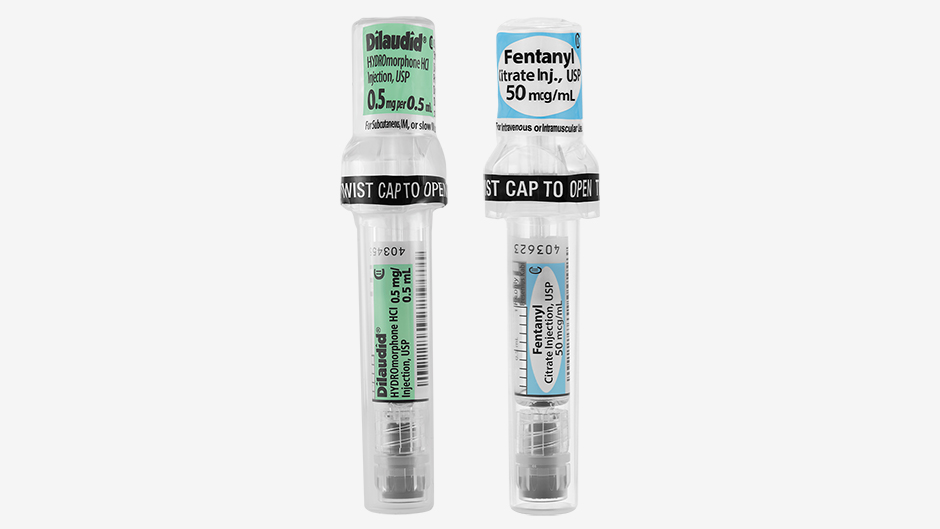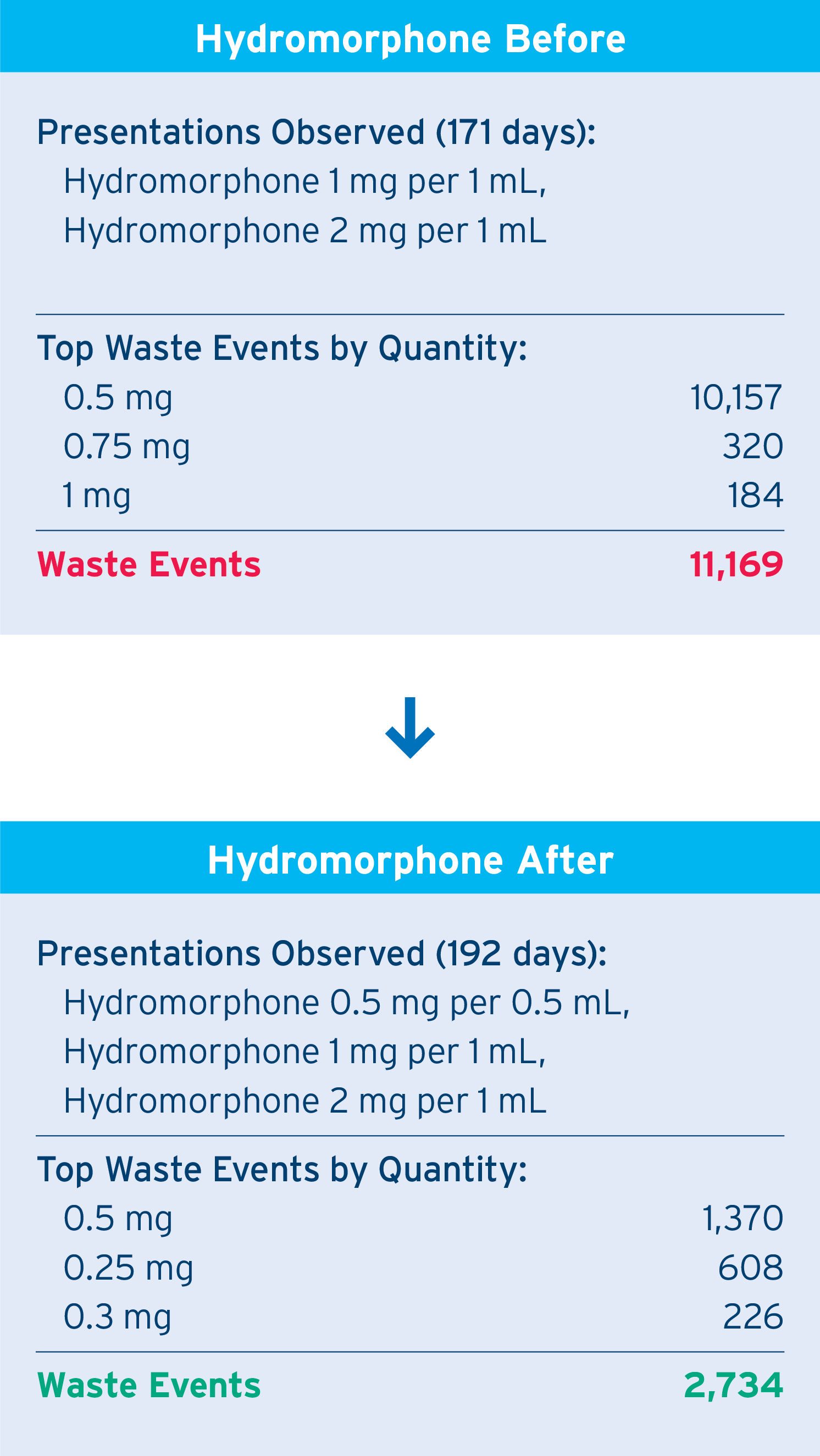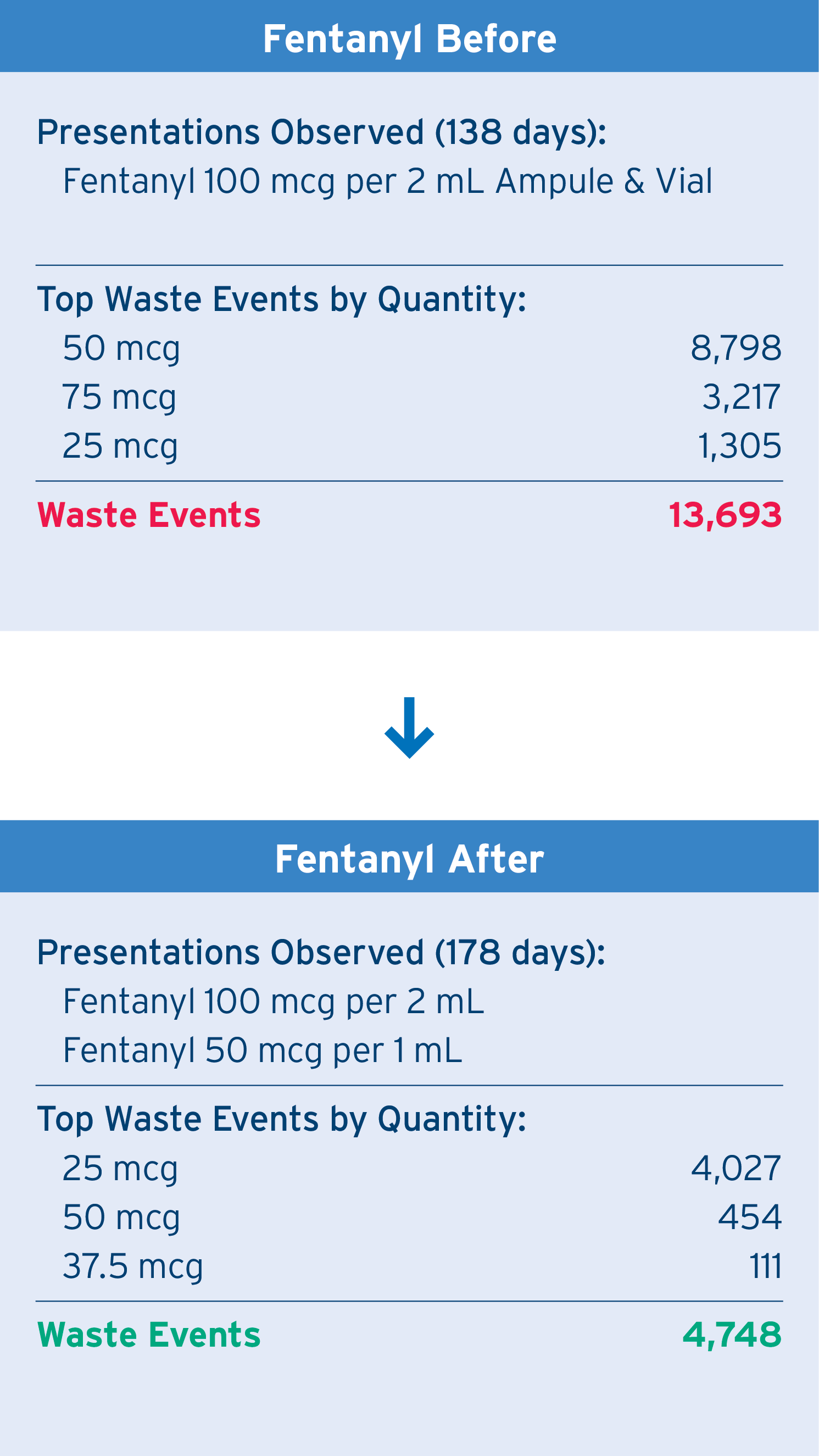78%
Reduction in overall Hydromorphone waste events*
73%
Reduction in overall Fentanyl waste events*
955
Nursing hours saved annualized
The Challenges
- Numerous drug shortages
- Time required to appropriately dispense and waste controlled substances by nursing staff
- Maintaining chain of custody and performing waste transaction audits
The Solution
- Use Simplist MicroVault® ready-to-administer prefilled syringes to more closely match clinical practice for commonly used opioid medications, such as hydromorphone and fentanyl
The Impact
- Decreased hydromorphone and fentanyl waste by 78% and 73%, respectively, resulting in fewer opportunities for potential drug diversion
- Decrease time spent documenting waste transactions with a witness resulting in increased time spent performing patient care activities
- Reduce the time required for pharmacy staff to support the hospital’s opioid stewardship program
*Data provided by Banner University Medical Center and analyzed by Fresenius Kabi’s Simplist Support Team.
Introduction
Banner University Medical Center Phoenix, the largest hospital in the state of Arizona, is a world-class academic teaching hospital with more than 750 beds. Part of the Banner Health system, which operates more than 30 hospitals across 6 states, Banner University Medical Center Phoenix offers specialty services including advanced heart care, organ transplantation, high-risk obstetrics, orthopedics, and other high-level surgical care. The medical center is also a Level I Trauma Center, providing 24-hour in-house surgical coverage across dozens of specialty service lines.
Fresenius Kabi USA is a global, integrated pharmaceutical company dedicated to bringing lifesaving medications and solutions to clinicians. For more than 100 years, the company has been a leader in providing high-quality, affordable medications for chronically and critically ill patients. Fresenius Kabi is one of the largest generic injectable suppliers in the United States, offering over 260 drugs in over 600 presentations.
The Challenge
“Diversion of drugs from legitimate to illicit use is being recognized with increasing frequency in the United States. Although the full extent of diversion from health care facilities is unknown and probably unknowable, our experience makes clear that it is a considerable and ongoing problem. Addicted HCWs who are diverting drugs from the health care facility workplace pose a risk to their patients, their employers, their co-workers, and themselves. It is essential that all health care institutions have a robust system in place to identify and investigate suspected diversion as rapidly and efficiently as possible and that they implement policies and procedures that enable a standardized and effective response to confirmed diversion.”
Mayo Clinic Proceedings — 20121
To improve patient safety and more effectively combat drug diversion, hospitals, small and large, are looking for new ways to support their opioid stewardship programs. By doing so, they can help ensure the safe and effective use of opioid drugs across the hospital.
Banner University Medical Center Phoenix possesses a strong, multidisciplinary drug diversion committee to facilitate the institution’s own drug diversion prevention efforts. Allison Mruk, PharmD, BCPPS, Associate Director of Pharmacy at Banner University Medical Center Phoenix, oversees the hospital’s drug diversion prevention and response team, as well as the facility’s controlled substance handling. She said she appreciates the fact that there’s been a growing awareness surrounding the best practices of controlled substance management which positively impacts both her patients and employees at Banner Health. This translates to her colleagues being open to new opportunities to support the cause as well as the institution’s refined program.
“Having not just a standard approach to identifying potential diversion events, but a proactive approach, helps us decrease the risk, which is beneficial for our hospital,” she said. “We take our drug diversion prevention efforts very seriously and we are always looking for ways to make improvements. This allows us to help ensure that controlled substances are being utilized appropriately and we are putting patient safety first.”
Wasting events can increase opportunities for diversion.2 Banner University Medical Center Phoenix’s pharmacy department identified a place to reduce wasting when faced with shortages of a commonly used drug, 100 microgram vials of Fentanyl. Mruk’s colleague, Associate Director of Pharmacy Abe Charara, PharmD, BCGP, BCPS, recognized that, by stocking a different presentation size of this commonly used narcotic, he and the pharmacy team could both overcome the current supply chain challenges and reduce wasting events.
“I analyzed a download of all of our usage, including the doses that were most frequently administered,” he said. “When we looked at the average dose, we realized the most common dosage was 50 micrograms. Given those numbers, and the shortages we were facing, it made sense to move to a different product.”
The Solution
Per the American Society of Health System Pharmacists (ASHP), best practices for preventing the diversion of controlled substances include minimizing waste. In ASHP’s 2022 Guidelines on Preventing Diversion of Controlled Substances,2 they state, “when possible, controlled substances are [recommended to be] stocked in ready to-use form and in the lowest commercially available units for doses frequently prescribed for patients.”
Banner University Medical Center Phoenix had already implemented automated dispensing systems to track their controlled substance use and wastage. After Charara’s analysis, they moved to add Simplist ready-to-administer syringes from Fresenius Kabi in smaller presentations of opioid analgesics or controlled substances: Simplist Dilaudid® (HYDROmorphone HCI) Injection, USP 0.5 mg per 0.5 mL and Simplist Fentanyl Citrate Injection, USP 50 mcg per 1 mL.
“Our goal was to reduce waste transactions, and in the process, reduce potential opportunities for diversion by moving to these presentations,” said Jeffrey Anderson, PHARMD, BCPS, FACHE, Banner University Medical Center Phoenix’s Director of Pharmacy. “We also appreciated that the packaging of the Simplist syringes came with tamper-evidence.”

See full Important Safety Information, including Boxed Warning
The Results
After integrating the new Simplist ready-to-administer syringes into their existing medication management system, Banner University Medical Center Phoenix met their goals of reducing controlled substance waste across the facility — supporting the hospital’s overarching drug diversion prevention program. The addition of ready-to-administer syringe products that more closely aligned with the clinical practice numbers uncovered by Charara’s analysis reduced hydromorphone and fentanyl waste by 78% and 73%, respectively.
“I was proud to present these results at our quality and safety council meeting earlier this year and show the reductions. The team was blown away. Nursing loved the impact the change had made in waste reduction and the potential labor reduction, as well.”
Jeffrey Anderson, PHARMD, BCPS, FACHE — Director of Pharmacy at Banner University Medical Center Phoenix
WASTE DATA OBSERVED: PRODUCT OPTIMIZATION OPPORTUNITIES
The switch to the smaller presentations Simplist prefilled syringes also helped to reduce both drug costs and nursing time. Based on the framework demonstrated in A Continuous Observation Workflow Time Study to Assess Intravenous Push Waste (2020),3 both product waste and nursing workforce time waste were calculated for the waste amounts observed before and after the Simplist ready-to-administer syringes in the new presentations were adopted.
The change resulted in a savings of 955 hours of nursing time when annualized. The cost of the waste reduced was calculated to be approximately $154,200 per year when annualizing the product cost and wasted workforce time.
Anderson said the results, taken together, help to show his nursing colleagues how the organization is working to improve clinical workflows for these vital clinicians.
“It’s important to us that we can show our nursing team that we are working hard to improve the quality of their work life and make things easier for them,” he said. “With less product waste, there are fewer trips to the Pyxis machine. Fewer witnesses required. And that means there’s more time for them to be with their patients.”
Let's reduce narcotic waste together
Schedule a call with our Pharmacy Analytics team for a custom analysis

